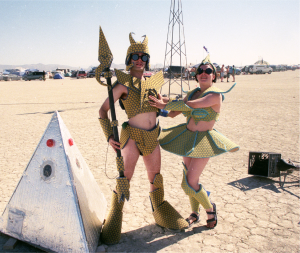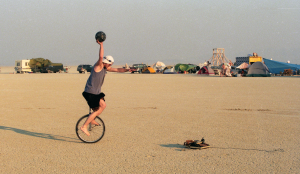Los Angeles Times, Sept. 4, 1996
COPYRIGHT (c) 1996 Times Mirror Company
Where the Wild Things Are
By MACK REED, TIMES STAFF WRITER
BLACK ROCK DESERT, NEV.
 They say this, those who gravitate year after year to this sunblasted wasteland like bedazzled moths to the promised flames of the Burning Man Festival: You can’t put it in a box.
They say this, those who gravitate year after year to this sunblasted wasteland like bedazzled moths to the promised flames of the Burning Man Festival: You can’t put it in a box.
Everyone tries, but labels fail: Road Warrior Meets Woodstock. Arts festival, survival test, mosh pit, pyro-jam, cyber-klatsch. Disneyland for weirdos.
This year, it was all of these, but like a virus morphing to survive in the face of all the forces that would kill it, it is mutating. And growing.
What began 11 years ago with San Francisco conceptualist artist Larry Harvey and a few friends torching an effigy on a beach to purge the pain of his doomed romance has blossomed, this year clustering an estimated 10,000 to 12,000 souls in this godforsaken desert 90 miles northeast of Reno for a five-day cultural brawl that culminated in the wee hours of Monday morning.
Early on, a ragtag tent city is splattered here at the elegant feet of the plywood-boned, neon-veined Burning Man himself, who stands as mute totem. Not burning. Not yet.
First, his acolytes from San Francisco, Los Angeles and other points far away must roar across the trackless, sun-hammered expanse of this ancient lakebed, trailing ochre plumes of dust. They must pitch camp on an unforgiving, 107-degree, 400-square-mile frying pan of cracked alkali mud that atomizes into fine, nose-clogging grit at the merest brush of tire or puff of breeze.
 For five days and nights, this seething mass of humanity must use machinery, explosives, glitter, drugs, gasoline, iconoclasm and noise to commit what can only vaguely be described as art – their offering to the Burning Man’s single credo, NO SPECTATORS, ONLY PARTICIPANTS.
For five days and nights, this seething mass of humanity must use machinery, explosives, glitter, drugs, gasoline, iconoclasm and noise to commit what can only vaguely be described as art – their offering to the Burning Man’s single credo, NO SPECTATORS, ONLY PARTICIPANTS.
Then, and only then, does this mob of club ravers, performance artists, hippies, gun lovers, neoprimitives, gearheads, firebugs and techno-geeks fully congeal into the commmunity that marches out Sunday night to the edge of what has become Black Rock City to lay torch to the Burning Man.
On Sunday afternoon, Harvey stands at center camp, chugging mineral water and fairly cackling at what he has wrought. Some mourn the population explosion from last year’s 6,000 as an influx of passive, slack-jawed gawkers and the death of Burning Man cool.
Harvey looks out at the Pro-Day-Glo activists chanting“If You’re Not Bright, You’re Dull” at the ornately painted nude men bicycling past and the TV camera crews sucking it all in, and grins the grin of a proud agitator.
“I welcome the large numbers” he says.“Because if we can do this and survive – if nothing else – it will prove how powerful a force culture can be if it’s given a chance to flower”
Someone bellows, “Burn the m———-r!” and Harvey laughs.“I love hearing that.”
 But as Burning Man grows, so does its reputation, and the burden of sweat, planning and diplomacy its organizers must bear for it to exist. The $35 ticket cost pays for chemical toilets, generators and sound system and a blizzard of informational flyers, plus a $1.50 daily fee per person to the Federal Bureau of Land Management for the use of the playa.
But as Burning Man grows, so does its reputation, and the burden of sweat, planning and diplomacy its organizers must bear for it to exist. The $35 ticket cost pays for chemical toilets, generators and sound system and a blizzard of informational flyers, plus a $1.50 daily fee per person to the Federal Bureau of Land Management for the use of the playa.
Chris Campbell clambers over the Burning Man, fretting over the festival’s potential to collapse under its own weight. Since Tuesday, (8/27), he has been troubleshooting neon, checking rigging and wiring fireworks to the sculpture–the fifth he has been commissioned to build in his San Francisco back yard.
“I don’t see how it can get any bigger” he says over the din of vehicles rumbling nonstop into camp.“The logistics are just too much.”
 Each year, Pershing County sheriffs bust a few more belligerent drunks and dopers, the BLM faces a few more tons of unwanted trash, and medical helicopters airlift out a few more victims of heat prostration, drug overdose or their own stupidity.
Each year, Pershing County sheriffs bust a few more belligerent drunks and dopers, the BLM faces a few more tons of unwanted trash, and medical helicopters airlift out a few more victims of heat prostration, drug overdose or their own stupidity.
This year saw Burning Man’s first fatality, when San Francisco neon artist Michael Furey, 37, motorcycled into camp with his headlamp dark after a night of drinking in nearby Gerlach and slammed head-on into a van in the omnipresent haze of playa dust.
Three other people were seriously injured early Monday morning – one critically – when a car drove over their tents.
“I think there’s a general concensus … that the Burning Man Festival has outgrown itself” said Ron Skinner, the weary sheriff of Pershing County, vowing to stop Burning Man 1997 from ever taking place without radical structural changes.
“My whole, entire staff is just totally burned out from the last five days,” he said.
“We’re a small department that serves 4,700 to 5,000 people, and we’re just not equipped to handle 10,000 partygoers. … The rebellion and indulgence is really replacing the art aspect of the whole event.”
The more the media hypes the Burning Man, the more static he draws: Some Christians call him pagan. Some women call him sexist. Some African Americans say he reeks of Klan cross-burnings.
Jeff Holmes, a Boulder Creek, Ca. Internet specialist, sees an energetic cross-pollenation of neotechnologists, performance artists, mechanics and free thinkers – and the potential for the whole exuberant, inebriated mess to reach critical mass and melt down.
“It’s balanced on a knife edge” he says.“But you know what? It’s going to go on regardless.”
At stake, some say, is the soul of the Burning Man. A Russian immigrant woman, her face adorned with a rainbow sticker, sidles up to Harvey one afternoon and grills him about whether all this fire, satanic mythmaking and “devilish, sinful things” are only nurturing evil.
“I don’t see a whole lot of devilish, sinful things going on” said Harvey, who masterminded Helco, a satirical corporate entity of mass consumerism and credit card culture headed by Satan himself. Motto: “Enjoy Now. Pay Later. Much Later.”
“The moral person contemplates evil,” Harvey tells her carefully. “The evil person commits it. And a person without a sense of humor can’t distinguish between the two … I know a lot of people who live in Marin County and contemplate spirituality and never get out of the hot tub.”
If nothing else, Burning Man is as much a jape as a celebration of the bizarre.
The Disgruntled Postal Workers prowl the camp in a barking, flashing Buick, delivering copies of the camp’s Black Rock Gazette with plastic Uzis and surly snarls.
A transsexual accordionist belts out a hilariously bawdy song about her transformation from man to “white trash whore.”
 The Black Rock desert itself – the limitless reach of dusty playa – encourages freedom of thought and deed.
The Black Rock desert itself – the limitless reach of dusty playa – encourages freedom of thought and deed.
And the life cycle of Burning Man culture maps itself onto the desert’s ruthless clock.
Mornings – if a little bleary from the night before – are tranquil, cool and bright. Early risers go solo on costumed walkabouts: one in a green velvet babydoll. Another in a transparent gauze djellaba. Many in nothing but shoes.
Some pilot their toys. A fuzz-cloaked dirtbike shaped like a giant rat, a shark-finned van, a motorized couch with a reading lamp tagging along on robot treads.
Hardcore artists labor in the rising heat. They slather mud onto a baroque castle of rebar and chickenwire, fine tune the fuel flow on their flamethowers, wire explosives to blood-daubed portraits of Tom Cruise and Jim Carrey and weld rusty sawblades onto a monstrous, pedal-driven juggernaut.
When afternoon comes, and the desert speaks: Winds kick up choking dust, and the heat swells, splitting the crowd in two: those who crash beneath sunshades and lean-tos to store energy for the all-night insanity. And those who commit insanity now.
A skateboarder with a megaphone rumbles across the playa at 20 mph, shouting directions to the truck driver towing him. Cursing sailors steer a Winnebago pirate ship through the heat haze, dragging a huge stuffed Barney doll. A leering silver shark car lurches up behind and chomps Barney to fluff.
Steve Lerner, of the Irrational Geographic Society, extols the power of his Alien Repellent Device, a silver pyramid with flashing lights. He points to a reddish smear on one of its corrugated sides.
“It’s like a bug zapper. Do you agree that playa dust is white? That there is no red dust anywhere out here? There is alien blood splattered on the side of this, my friend.”
 A bowling-ball wielding unicyclist pounds a typewriter to scrap. A white plastic garden of spoons sprouts from the desert.
A bowling-ball wielding unicyclist pounds a typewriter to scrap. A white plastic garden of spoons sprouts from the desert.
Night falls, and the sound systems kick in, pumping out acid house, space jazz and jungle dubs. Bands roar onto the stage like !TchKunG!, a tribe of barechested, hard-drumming, fire-eating eco-zealots, who rage against clear-cutting and chainsaws.
A topless mime couple act out an increasingly invasive doctor’s visit that decays into a body-piercing burlesque and culminates when she draws blood from his arm and smears it over both their faces, all to the warped tune wheezing from topless transsexual Baby Dee’s accordion.
 Then, a naked cast of more than 100 satyrs, demons, wraiths and nymphs in the gothic opera “The Arrival of Empress Zoe” caper around the mud castle, the huge oak logs inside its turrets now ablaze and its gargoyles belching gouts of flame.
Then, a naked cast of more than 100 satyrs, demons, wraiths and nymphs in the gothic opera “The Arrival of Empress Zoe” caper around the mud castle, the huge oak logs inside its turrets now ablaze and its gargoyles belching gouts of flame.
And on the final night, when everyone has danced and sang and built and painted and drunk and drugged and smashed and burned all they can, they stream out across the cooling basin to watch the Burning Man himself burn in an explosion of fireworks, wax-soaked burlap and bursting neon tubes.
 And thus anointed with ashes, mud and dust, they lay plans for next year.
And thus anointed with ashes, mud and dust, they lay plans for next year.
